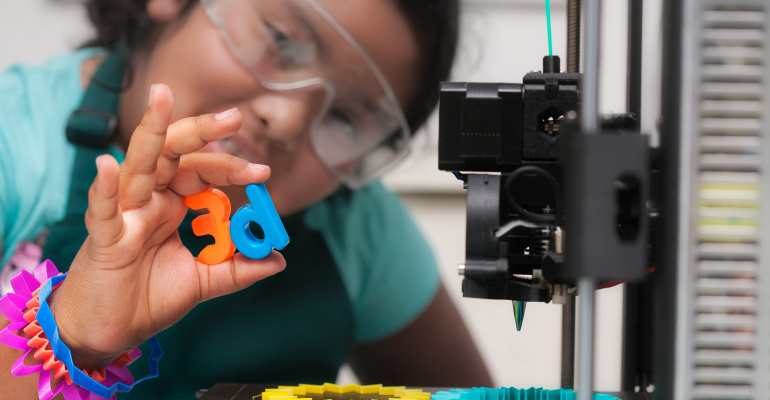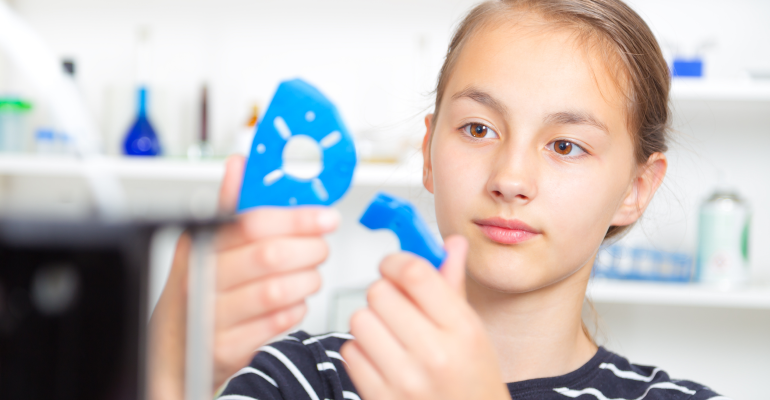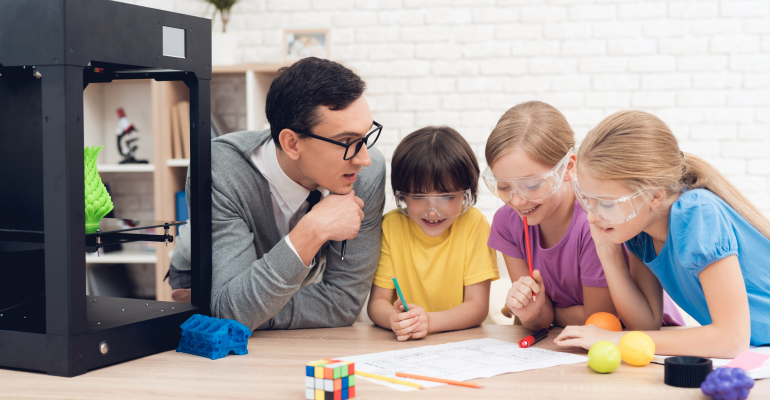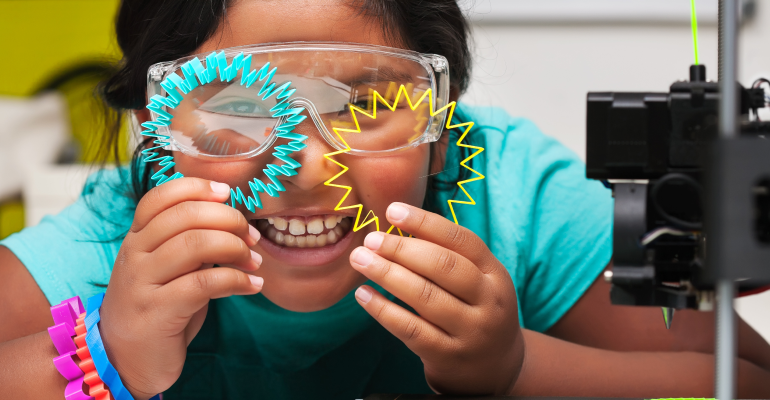Generate classroom engagement in STEM and create future engineers with exciting 3D printing projects.
When it comes to capturing students’ attention and interest, middle school teachers may find 3D printing and rapid prototyping to be particularly impactful learning tools, giving the young learners the chance to create something tangible out of seemingly nothing. Rapid prototyping and 3D printing are important aspects of a thorough STEM education, building on foundational fluencies students already have and inspiring a continued love of engineering principles.
In this article, we’ll break down how to integrate rapid prototyping and 3D printing lessons into a middle school STEM curriculum, plus its benefits, key examples, and lesson ideas.

Basics of Middle School STEM
Before exploring rapid prototyping, let’s establish the basics of effective middle school STEM education. By the sixth to eighth grade, which are typically the middle school years, students will likely have encountered the foundational fluencies in STEM in some manner.
If they’ve been following a structured STEM curriculum, students will begin exploring more challenging concepts that integrate with the world around them, including structural engineering, mechanical engineering, physics, rapid prototyping, 3D printing, computer science, and robotics.
Middle school STEM education should place an emphasis on STEM identity, which is seeing oneself as capable of learning and understanding science, technology, engineering, and math. By middle school, STEM identity may be at a precarious intersection, with some students thinking that the subjects are too difficult or just not for them. Kid Spark Education aims to engage with those students in an accessible and enjoyable manner, reigniting their potential in STEM subjects.
Students studying STEM in middle school will develop critical thinking skills and begin to put together the different concepts they have learned. They can see the real-life implications of STEM with lessons that include such tasks as 3D printing.
What is Rapid Prototyping in STEM Education?
Rapid prototyping is a term you will hear not only in STEM education, but also in practical fields like engineering and even in UX design. Rapid prototyping is the process of quickly creating a physical part directly from designs, thus allowing the evaluation of the product or part. This outputs a prototype, which is a basic version of what the final product may be.
According to a study conducted by Alignment Nashville, “Rapid prototyping used as a strategy for engaging middle and high school students in STEM careers aligns nicely with the latest information in cognitive research.”
In STEM education, rapid prototyping can spark the interest of creative-minded students since it involves the hands-on creation of an object. Middle schoolers can form the connection between abstract concepts and real outputs.

What is 3D Printing in STEM Education?
A relatively new invention, 3D printing is “the manufacturing of solid objects by the deposition of layers of material (such as plastic) in accordance with specifications that are stored and displayed in electronic form as a digital model,” as defined by Merriam-Webster.
Students may use computer-aided design (CAD) programs to create these 3D parts and prototypes. According to the Institute of Electrical and Electronics Engineers (IEEE), 3D CAD programs have been a part of middle school and high school education since the early 2000’s, but it was only with the recent advent of affordable 3D printers that students were able to see the physical manifestation of their prototypes.
3D printing is one way that students may complete rapid prototyping during their STEM labs.

Why Use 3D Printing in Middle School STEM
One study by the University of Arkansas exposed high school students to a 3D printing, STEM-focused presentation. The participants reported an increased interest in the relevant technology and STEM-based career paths. Interestingly, many of these students had minimal knowledge of STEM prior to the presentation.
Middle school STEM programs that include 3D printing get ahead of that trend, giving students in vital grades a knowledge of and passion for STEM topics like rapid prototyping. The hands-on aspect of using a 3D printer can be particularly appealing to students with different learning styles.
Additive Manufacturing broke down six possible use cases for 3D printing in education, which were:
-
Teach students about 3D printing
-
Teach educators about 3D printing
-
Support teaching with technology
-
Create materials that aid learning
-
Create assistive technologies
-
Support outreach activities
As 3D printing technology continues to develop, it becomes more attainable for schools to be able to afford their own 3D printers and 3D printing pens. This creates the opportunity for rapid prototyping to be integrated into the STEM curriculum.
3D Printing STEM Labs for Middle Schoolers
So what does a 3D printing or rapid prototyping STEM lab look like in a middle school classroom? Let’s break down what makes Kid Spark Education a great choice for middle school STEM labs, then explore the details of a Kid Spark STEM lab on the subject.
Kid Spark Education Rapid Prototyping Labs
Kid Spark Education features 3D printing and rapid prototyping in its sixth to eighth grade curriculum. Since we seek to bring educational equity to STEM learning, educators can rest assured that our programs will be accessible to students of all backgrounds and abilities, with group learning as a key feature to allow students to support one another.
Kid Spark Education provides support for the educators facilitating these lessons thanks to a complete curriculum, workbooks, professional learning modules, and instructional videos.
Our programs follow the International Society for Technology in Education (ISTE) standards for students along with the three Next Generation Science Standards (NGSS): Science and Engineering Practices, Crosscutting Concepts, and Disciplinary Core Ideas.
Kid Spark Education STEM Unit: Taking Flight
Recommended Grade Level: 6 - 8
Kid Spark STEM Lab: STEM Pathways
This unit is described as the following:
“In this unit, students will learn the basics of how to create custom, 3D printed components using Tinkercad. Students will gain confidence as they design and print a custom airplane propeller that snaps onto a model airplane. Then, students will have an opportunity to apply what they have learned throughout the unit as they participate in a fun free build challenge.”
This middle school STEM lesson gives students the opportunity to design and create the working propeller for a model airplane, using the materials in the Kid Spark STEM Pathways kit.
Students will use Tinkercad, which is a CAD program, to explore, design, and export different parts. This gives the students the opportunity to immerse themselves in the technical workspace of the program, so those learners who prefer to embrace technology rather than hands-on tasks will also have something to be excited about in the lesson.
Once students complete a standard curriculum, like the “Taking Flight” unit from Kid Spark Education, rapid prototyping can be applied to other projects. For example, students might decide on a particular manufactured product they want to create, like a claw for picking up trash, and use the tools and skills they have at hand to do so.

3D Printing Gets Middle Schoolers Excited About STEM
With so many students being hesitant about STEM, educators often find themselves seeking ways to plant excitement and engagement among their students. Middle school is a particularly pivotal time for many of these adolescents, making the challenge even greater.
Rapid prototyping STEM labs, including those that feature 3D printing, are a great way to integrate a hands-on approach to STEM learning. Kid Spark Education features all-in-one middle school STEM lessons on rapid prototyping, backed by research and key educational standards.
Create an account to explore sample middle school STEM curriculum, or contact our team today to learn more about our programs.
.png?width=1270&height=453&name=Copy%20of%20Kid%20Spark%20Logo%20(Horizontal%20-%20Full%20Color).png)